Typical oil stain incidents in homes
How to lift oil stains from concrete? This is one of the most common questions new homeowners ask daily.
Oil stains on concrete are a common problem in many homes, especially those with garages, driveways, or patios. They can occur in various ways, such as vehicle leaks, accidental spills, improper storage, or even pet accidents. Oil from cars, motorcycles, or lawnmowers can drip onto concrete surfaces, leaving behind unsightly stains. Additionally, spills of cooking oil, motor oil, or other oily substances can happen in garages, workshops, or even kitchens, leading to stains on concrete floors. Improper storage of oily materials, like paint or solvents, can also result in spills and subsequent stains.
Moreover, pets, particularly dogs, can track oil onto concrete floors from their paws or fur, especially after being outside or around vehicles. These are just a few examples of how oil stains can appear on concrete surfaces in homes. Regular maintenance, proper storage, and prompt cleanup of spills can help prevent these stains from occurring.
But before we can discuss lifting oil stains from concrete, let’s discuss more common concrete problems, like concrete lifting.
Understanding Concrete Lifting
‘Concrete lifting near me’ is one of the top-ranked searches on Google. Why? Because concrete lifting jobs are quite significant, especially for homeowners. Concrete lifting is also very common, so even if you haven’t had the pleasure of encountering it yet, you will in the future!
Concrete lifting is a specialized process that involves raising sunken or uneven concrete surfaces. It’s a complex task that requires knowledge, skill, and specialized equipment. While it may seem tempting to attempt concrete lifting as a DIY project, leaving it to professionals is strongly recommended.
Understanding Concrete Lifting Foam
Concrete lifting foam is a specialized polyurethane material designed to elevate sunken or uneven concrete slabs. This high-strength foam is injected beneath the affected area, where it expands uniformly to lift the concrete back to its original level.
The foam’s unique properties make it ideal for concrete lifting applications. It is low-density, ensuring that it does not add excessive weight to the structure. Additionally, the foam is closed-cell, meaning it is resistant to water and other elements, providing long-lasting support. The foam’s ability to expand predictably and uniformly is essential for achieving precise and even lifting results.
The Dangers of DIY Concrete Lifting
There are several reasons why do it yourself concrete lifting is not advisable. First, it requires a deep understanding of concrete chemistry, structural engineering, and the appropriate techniques. Without this expertise, you risk causing further damage to the concrete. Second, the tools and equipment used for concrete lifting are specialized and require proper handling. Using the wrong tools can lead to ineffective results or even accidents. Third, concrete lifting can involve hazardous materials and heavy machinery. Without proper safety precautions, you could put yourself and others at risk. Finally, many concrete manufacturers offer warranties on their products. If you attempt to lift the concrete yourself and cause damage, you may void the warranty.
As professionals, we cannot stress how important it is for you to not buy into the do it yourself concrete lifting hype. DIY can be fun and cute, but when actual projects are involved that involve the structure of your house, you should leave it to the professionals.
The Importance of Professional Concrete Lifting Services
When it comes to concrete lifting, it’s always best to leave the job to professionals. They have the necessary training and experience to assess the situation accurately and choose the most effective lifting method. Additionally, they have access to specialized equipment and tools that are essential for successful concrete lifting. Professionals also know how to work safely and minimize risks. Furthermore, they are typically insured, which can provide peace of mind in case of accidents. By hiring professionals, you can be confident that the job will be done right the first time, ensuring the longevity and structural integrity of your concrete.
Removing Oil Stains from Concrete
Now that we’re all caught up on concrete lifting, let’s address the primary concern: removing oil stains from concrete. The most effective method depends on the type of oil, the age of the stain, and the severity of the discoloration.
To remove oil stains, start by identifying the type of oil. This will help you choose the appropriate cleaning agent. Once you’ve determined the oil type, prepare the area by clearing away any debris. Wear protective gloves, eye protection, and appropriate clothing.
For fresh stains, a commercial degreaser is often effective. Apply it generously to the stain and allow it to sit for the recommended time before scrubbing with a stiff-bristled brush. For older or particularly stubborn stains, a specialized concrete cleaner may be necessary.
After scrubbing, rinse the area thoroughly with clean water to remove any residual degreaser or oil. If you used an acidic cleaner, neutralize the concrete by applying a solution of baking soda and water.
Future protection against oil stains on concrete
To protect the concrete from future stains and weathering, consider applying a sealant. Sealants can help repel moisture and oil, making it easier to clean up spills in the future.
Remember, acting quickly is key when dealing with oil stains. The sooner you address the stain, the easier it will be to remove. Avoid using harsh chemicals, as they can damage the concrete. For large areas or stubborn stains, pressure washing can be a helpful tool. However, be cautious not to use excessive pressure, as this can damage the concrete.
If you’re struggling to remove an oil stain or if the stain is particularly large or severe, it may be best to consult a professional cleaning service.
By following these guidelines and seeking professional help when necessary, you can effectively remove oil stains from your concrete surfaces and restore their appearance.
Final Thoughts on How to Lift Oil Stains From Concrete
Now that you’re well versed on how you can lift and remove oil stains from concrete in your home, don’t forget that oil stains are normal and a very good sign of a well-lived-in home. A few beauty marks only help give the home more sentimental value. However, if the oil stains are too obvious or look very out of place then you know how you can get rid of them.
We hope this guide helped you know more about oil stains and concrete problems than you did before. Remember, if you’re looking for excellent mudjacking services that involve concrete lifting and such, call the Mudjacking Contractor today by visiting our website or calling us at (347) 284-0280.
FAQs
How to Remove Dried Oil Stains From Concrete?
To remove dried oil stains from concrete, first apply a degreaser to the stain and let it sit for a few minutes. Then, scrub the area with a stiff brush or broom. Rinse thoroughly with water. If the stain persists, repeat the process or try a stronger degreaser.
____________________________________________________________________________
Do Oil Stains Eventually Come out of Concrete?
Yes, oil stains can eventually come out of concrete, but it may take time and effort. The best way to remove them is to use a degreaser and scrub the area thoroughly. If the stain is stubborn, you may need to repeat the process or try a stronger degreaser.
____________________________________________________________________________
Are Oil Stains Permanent?
No, oil stains are not permanent. They can be removed with proper cleaning methods and products.
____________________________________________________________________________
Why Do Oil Stains Not Come Out?
Oil stains can be stubborn and may not come out easily due to several factors, including the type of oil, the length of time the stain has been there, and the porosity of the concrete. Additionally, some oils, such as motor oil, may contain additives that make them more difficult to remove.
____________________________________________________________________________
Is Concrete Lifting a Good Idea?
Concrete lifting can be a good idea for raising sunken or uneven concrete slabs. It is often a more cost-effective and less disruptive alternative to traditional methods like excavation and underpinning. However, the suitability of concrete lifting depends on factors such as the extent of the damage, the type of concrete, and the underlying soil conditions. It is best to consult with a professional to determine if concrete lifting is the right solution for your specific situation.
____________________________________________________________________________
What Are the Different Types of Concrete Lifting?
There are two main types of concrete lifting: hydraulic lifting and polyurethane foam lifting. Hydraulic lifting involves using hydraulic jacks to physically lift the concrete slab. Polyurethane foam lifting, also known as foam jacking, involves injecting expanding polyurethane foam beneath the concrete to lift it.
____________________________________________________________________________
What Material Is Used to Lift Concrete?
Polyurethane foam is commonly used to lift concrete. It is injected beneath the sunken area and expands to lift the concrete back to its original level.
____________________________________________________________________________
How Thick Should Concrete Be for a Lift?
The thickness of concrete required for a lift depends on several factors, including the type of concrete, the weight of the structure above it, and the extent of the lifting required. However, as a general rule, concrete should be at least 4 inches thick to be suitable for lifting.
____________________________________________________________________________
How to Test Concrete for Lift?
To test concrete for lift, you can perform a deflection test. This involves applying a load to the concrete slab and measuring the amount of deflection. If the deflection is excessive, it may indicate that the concrete is not suitable for lifting. Additionally, a visual inspection can help identify any signs of damage or deterioration that may affect the lifting process.
____________________________________________________________________________
How to Reinforce Concrete for Lift?
To reinforce concrete for lifting, consider adding reinforcing bars, incorporating fibers, applying chemical treatments, or providing temporary structural support. Consult with a structural engineer to determine the best approach for your specific situation.

